Drywall is also called gypsum board, sheetrock, plasterboard, or more generally, wallboard. We are going to look over the types and brands, and which chemicals they contain. Which ones have the least toxic additives, don’t offgas, and are the healthiest choices.
This article contains affiliate links, upon purchase I make a small commission at no extra cost to you.
What is Drywall Composed of?
The main ingredient in drywall is gypsum, so let’s start there and look at the health considerations of gypsum. There are two types of gypsum:
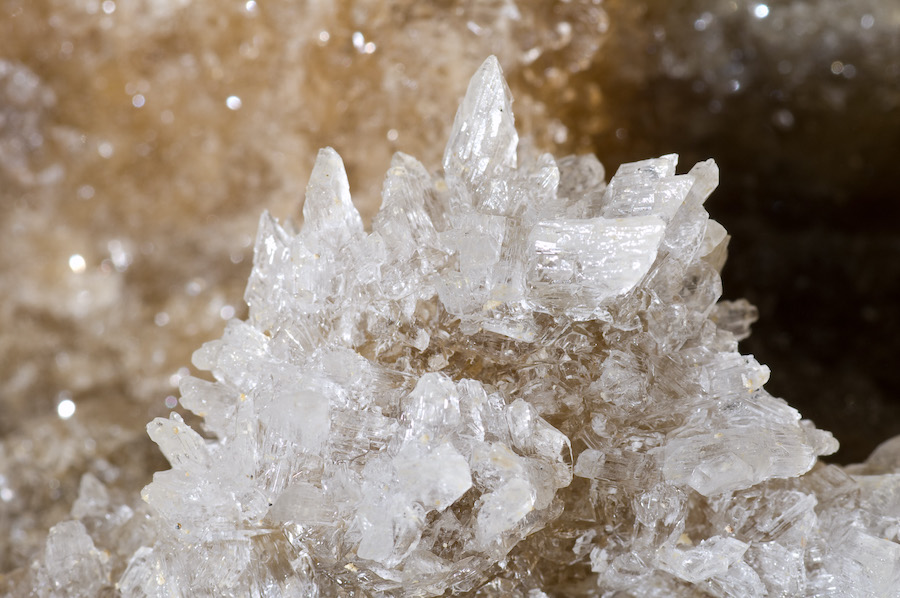
Natural Versus Synthetic Gypsum
Natural gypsum is a product mined from the earth. Synthetic gypsum is made from the byproduct of power plants, also called FGD gypsum. They are both technically gypsum.
Unless a product specifically states they use natural mined gypsum, it is exceptionally difficult to track which brands use which type, or if they use a mix.
- 30% of all drywall in North America is synthetic
- USG, the largest drywall manufacturer, has 21 drywall plants. 9 of those only use synthetic. 6 use a mix of the two source
What Else is Drywall Made Up Of:
- Drywall is 70-90% gypsum (synthetic, mined or mixed)
- 10% paper, on the paper-backed types
Other additives that may be included:
- Cellulose fibers (in monolithic drywall)
- Fiberglass fibers (fiberglass is in X and C types, and fiberglass backed drywall)
- Plasticizers
- Starch
- Finely ground mica crystal as an accelerant
- EDTA or other chelating agents
- Boric acid/borates
- Wax like paraffin or hydrocarbon, or silanes to hinder water absorption (on the greenboard types)
- Potassium sulfate
- Sodium sulfate
- Vermiculite (in Type C fire-resistant drywall)
- EVA as an adhesive
Source 1, source 2, and SDS sheets
Does Synthetic Drywall Contain Mercury?
Both synthetic and natural gypsum contain low amounts of mercury. It is regulated by the UL standard (ULE 100).
How Much Mercury is in Drywall?
The amount of mercury in synthetic gypsum varies depending on the power plant it came from (source).
It is also a trace metal found in natural mined gypsum. One study found the amounts were 0.92 ng/m2-day for natural gypsum wallboard and 5.9 ng/m2-day for synthetic gypsum wallboard. This resulted in mercury levels in the rooms that were below the background levels normally found indoors and within or below the levels found in outdoor air (source).
Therefore, mercury in drywall has not been a concern of mine. If you wanted to avoid all gypsum board you would be looking at alternatives like MgO board, tongue and groove wood (not allowed by all codes due to fire risk), or plaster and lath (wood or metal lath).
Or, you could minimize the amount of mercury by going with natural gypsum.
USG, Georgia-Pacific, CertainTeed, and National Gypsum are the main producers of gypsum board. These are all easy to source at building supply stores and through contractors. The gypsum could be natural, synthetic, or mixed, and it’s very difficult to find out which drywall line contains which type of gypsum.
Non-Toxic Drywall
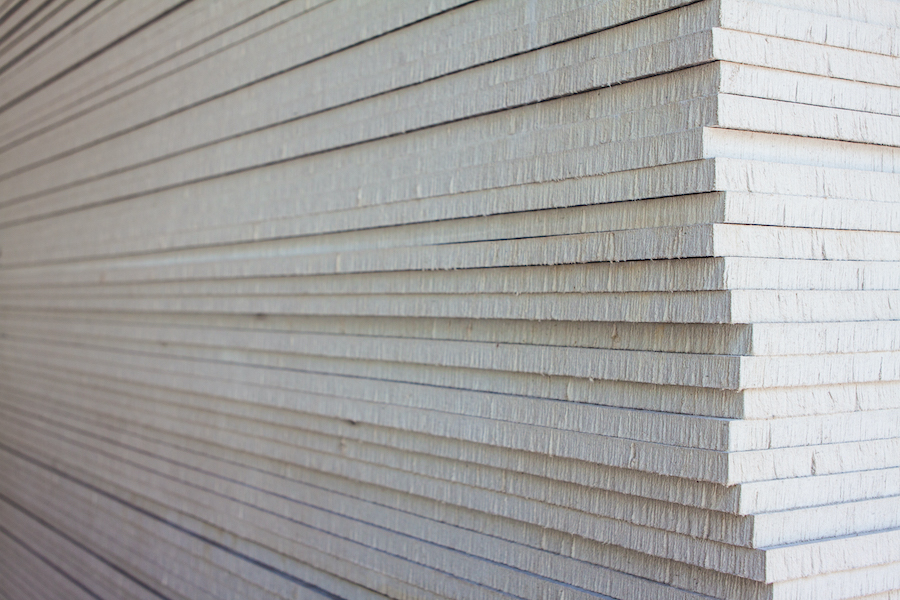
By Brand:
1. Natural Gypsum
National Gypsum makes gypsum boards that are VOC-free (the paper-backed ones). This brand tends to use natural gypsum.
Their standard line is the regular Goldbond. LITE may also work well for sensitive folks. More on “light” drywall below. The type X is a fire-rated drywall, it contains fiberglass.
You can source this through your contractor’s suppliers. You can get a test sheet at Lowes.
The use recycled paper to back the drywall (like the other major brands).
2. USG SheetRock
This is the largest drywall brand and the easiest to source. The SDS sheets claim 0-VOC. They also have GreenGuard Gold certification, which I discuss more below.
The “regular” drywall should contain the least amount of additives. They use recycled paper backing and facing, but there should be no mildewcide, fiberglass, or other major additives.
USG Sheetrock Ultralight – I have been happy with their Sheetrock Ultralight, I did not pick up any offgassing or moldiness in the paper. Although we don’t know what the blowing agent is (it could be air), I would feel comfortable using this one in my home due to my own testing of it. This is my go-to brand that I specify.
This one is inexpensive and easy to find. You can get it at Home Depot or through your contractor.
USG Firecode X – Research that a very sensitive client revealed that USG was the cleanest gypsum on the West Coast (as it contained more natural gypsum). Though these things change over time, and that same brand could be made in a different factory on the East Coast.
It does not contain a flame retardant, it does contain glass fibers (fiberglass). More on type X below.
3. Georgia-Pacific
Georgia-Pacific Gypsum boards are all GreenGuard Gold Certified. Their exact VOC levels are not listed on the SDS.
Like the other brands, they have a “standard” line which is what I would recommend as the safest bet. The “light” can be considered as well.
GP DensArmor Plus is the most popular fiberglass-backed drywall. No paper here. They recently made a statement that the Dens line is treated with biocides.
4. Certainteed
CertainTeed Gypsum boards claim zero VOC (no reportable VOCs), and they have GreenGuard Gold certification.
They have all the same categories of drywall types as the others.
Should You Use Paper-Backed or Fiberglass-Backed?
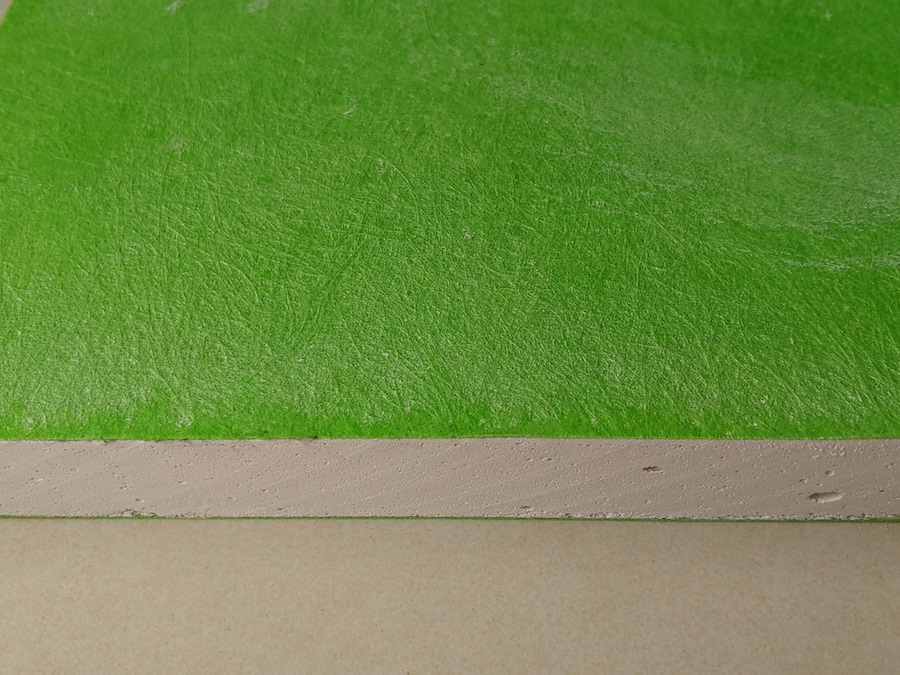
Many drywall companies use recycled paper which some folks are reluctant to use in their homes. One study showed that paper is already full of mold spores (source). The other concern is that if it gets wet it will mold faster than other materials.
If that is a concern of yours, I would check out the fiberglass-backed drywall and see if that is tolerable for you. Fiberglass is not totally odorless.
If it isn’t, keep in mind that you should not have moisture or condensation behind your wall if your wall is designed and built right. If you have a big leak you are likely to find that quite quickly. I would not rule out paper-backed drywall, personally.

Another type of drywall is called monolithic drywall (pictured above)- no paper and no fiberglass – such as the USG Fiberock line.
It does not have a backing, instead, it contains cellulose fibers dispersed throughout the gypsum. This is a less common type. If you have chemical sensitivities you should test it out yourself if you rule out the other two types. This is my top pick for the type of drywall to use on the bathroom walls (not behind tiles, just the walls).
You do need to skim-coat this type of wallboard (same goes for fiberglass backed).
Behind wet areas, concrete backer board should be used (not drywall) – that is discussed in the post on bathrooms.
Costs? Paper-backed drywall is the least expensive type, followed by fiberglass-backed, and then monolithic.
Types of Drywall with Special Properties – Which Chemicals are Added?
1. Fire-Rated Drywall
Type X drywall means it meets requirements for fire codes (that could be required in certain rooms of a house). This type contains glass fibers, is denser, and is 5/8th thick (regular drywall is ½ inch).
It is 10-20% more expensive than regular drywall.
Type C is another type of fire-rated drywall, with a higher rating than type X. It also contains fiberglass and a form of vermiculite. It is more expensive than type X and may be specified for certain areas.
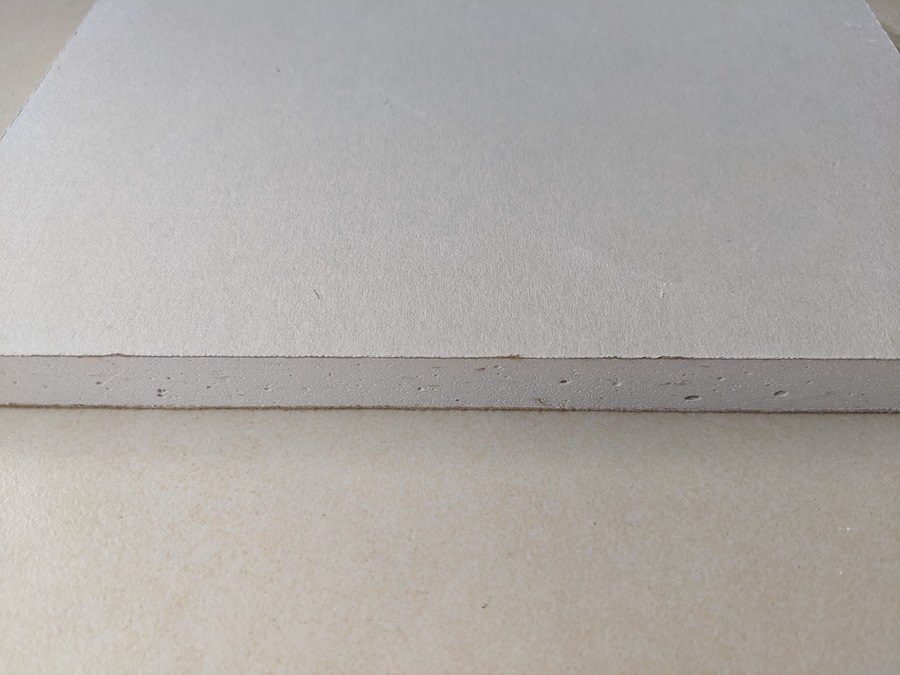
2. Drywall that Reduces Formaldehyde
CertainTeed’s AirRenew (GreenGuard Gold), claims to soak up formaldehyde. However, it also contains a biocide.
It is a little harder to source than the ones above. In Canada, you can find it at Lowes. Some have reported an odor with this one that might indicate that an additive used to soak up formaldehyde might not work for everyone.
This patent might be related to this brand.
3. Light Drywall
The major drywall companies all have lines that are lighter in weight, and these are very commonly used in construction. We don’t know what is added to light drywall that makes it light.
From my testing of it, I did not find that it had chemical offgassing, but we don’t know what the blowing agent is – it could be air or something that dissipates quickly (source).
I did well with USG Sheetrock UltraLite, and I don’t suspect a toxic blowing agent.
Borates are likely to be found in light drywall (source). The SDS will sometimes list borax.
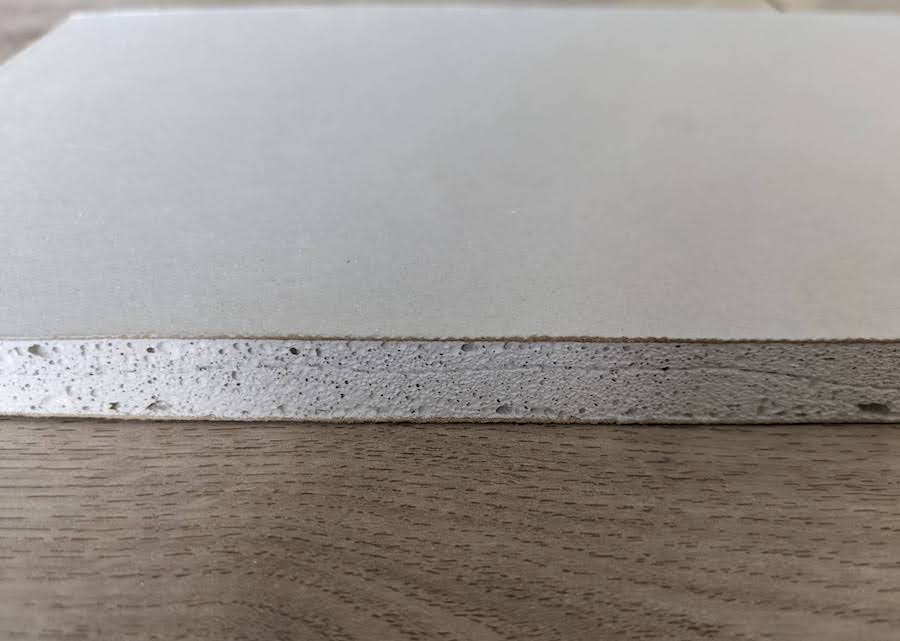
4. Mold Resistant Drywall / Green Board
Both the monolithic (homogenous) drywall and fiberglass-backed types are less prone to going moldy (or at least to going moldy as quickly) compared to paper-backed drywall.
Fiberglass-backed drywall is promoted as more mold-resistant, but all of the brands I have looked at including the Dens line do contain a mildewcide.
If it is labeled as “mold-resistant” and is paper-backed then you can expect a biocide.
Paperbacked brands with mildewcide in them include:
- Georgia-Pacific’s ToughRock Mold Guard -doesn’t disclose biocides but does disclose paraffin wax, polyvinyl alcohol, and poly(methylhydrosiloxane) which are moisture-resistant additives (HPD)
- Certainteed’s M2Tech – doesn’t disclose biocides but does disclose paraffin wax, polyvinyl alcohol, and poly(methylhydrosiloxane) which are moisture-resistant additives (HPD)
- National Gypsum Goldbond XP – as of 2023 the biocides are undisclosed but in the past, I found info that it was treated with thiabendazol, azoxystrobin, and fludioxonil (there’s also a European patent for these three chemicals used in drywall)
- USG Sheetrock Mold Tough line – treated with sodium pyrithione (source)
- Pharos also lists multiple sources for the use of sodium pyrithione (source)
“Green board” is a generic term for green-colored drywall like these that have biocide-treated paper and are meant for areas with more moisture.
GP’s ToughRock Mold-Guard, American Gypsum’s Aquabloc, and Sheetrock Mold Tough are greenboard. Purple drywall by National Gypsum is similar.
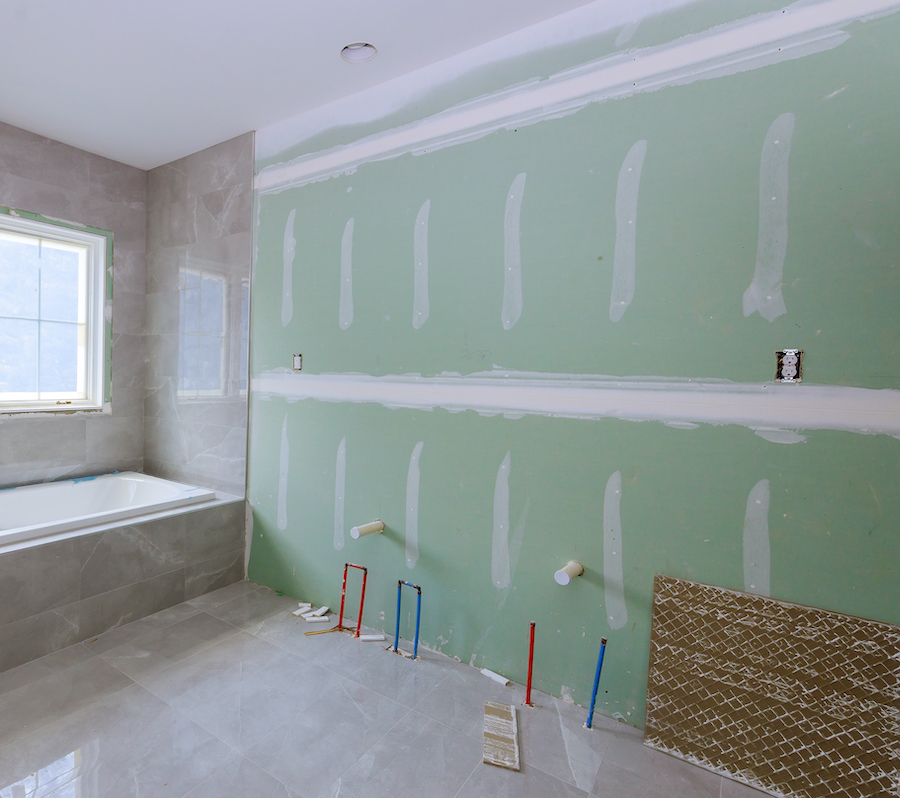
Additional Health Concerns with Drywall
Greenboard

It is not best practice to use greenboard (including the purple) behind tiles that get wet.
Best practice in this area is to use concrete backer boards with the Schluter system, or, Schulter or WEDI foam boards, discussed in this post on bathrooms.
If you want to create a mold-preventative shower, Schulter and WEDI are the best systems.
Using greenboard behind wet tiles can lead to mold if there is moisture. They also contain added mildewcides, so I prefer to avoid these types of drywall.
Sulfur Emitting Drywall

The “Chinese Drywall” debacle is the best-known case of a major problem in the drywall industry. Between 2001 and 2009 some drywall offgassed sulfur to the point of causing major problems.
There have also been lawsuits against American-made drywall, but they were dismissed.
I have not seen any issues with sulfur and drywall lately.
In every industry, these kinds of problems do crop up from time to time. Those very sensitive should use their own reactions to guide them. Drywall should never smell like sulfur, and if you react to it that won’t be good for you.
Those who are healthy or less sensitive should go with well-respected brands and do the best you can with the research that we have. Made in America may be better, but is no guarantee that there will not be problems.
The problematic drywall also contained strontium.
Silica Dust

When drywall is cut and when joint compound is in dust form (straight out of the bag or after sanding), silica, the same substance that glass is made of is, is harmful to breathe in.
Silica is perfectly safe when in solid form.
Be sure to take great caution when mixing up drywall mud, when cutting drywall, and when sanding the mud.
Use an N95 mask or better when around the dust.
The dust is very fine and difficult to remove, I have seen it in builds that are 2 years old. It clings to the wall so you have to clean it very thoroughly.
Make sure the central HVAC is off when drywall and drywall mud work is being done, there should never be drywall/silica dust in your ducts.
Products containing silica dust/quartz will have a Prop 65 warning, keep in mind it’s safe when in solid form.
Should your Drywall be Certified – GreenGuard Gold or UL?

The only benefit to a GreenGuard Gold product is it might catch these unusual problems with offgassing that have cropped up – either sulfur or formaldehyde.
More than a decade ago, some drywall did test positive for formaldehyde, in that sense, GreenGuard Gold is the best certification for this case, as it ensures the VOC levels are extremely low, the same as outdoor air. More details on GreenGuard levels in this post on certifications.
Those who do not want to over-research should go with a big brand Greenguard Gold line that does not contain mildewcides. National Gypsum Goldbond if you want natural mined gypsum.
Drywall should be zero-VOC, and in theory, does not give off formaldehyde at a detectable level.
UL 100 is somewhat helpful in that it regulates mercury, but I expect all drywall to have extremely minuscule levels of mercury.
For drywall mud (spackle/joint compound), drywall tape, and mud for textured walls see my dedicated post on this topic.
Related posts:
Non-Toxic Drywall Mud
Non-Toxic Plaster
Corinne Segura holds certificates in Building Biology, Healthier Materials and Sustainable Buildings, and more. She has 10 years of experience helping others create healthy homes.
Did you find this post helpful? If so you can buy me a coffee to support the research behind this blog. Thank you!
Sources:
2) The Spruce
3) SDS sheets for all the major brands
4) Teledy
5) Pub Med
7) Patent
8) The Spruce
9) Borax
10) ProPublica

LaLa
Thanks for the great article! I’m currently picking out a drywall for my bedroom and was going to go with Gold Bond because it sounds like that’s the best chance of getting natural rather than synthetic gypsum and it’s greenguard gold certified. However, when I look at the safety data sheets I grew concerned because it mentions a Prop 65 warning due to the respirable crystalline silica. In your experience, is that mainly a concern during the actual construction phase or are there still health concerns after the project is done because you mentioned the dust can be so difficult to remove and could stay around for 2 years? I’m unclear how concerned I should be about exposure to silica dust that might remain in the bedroom even after the work is done. Thanks!
Corinne Segura
They all have silica as do many other building materials. It’s only a concern in dust form, and it’s only a prolonged concern if it gets in your HVAC duct work so make sure to seal up and turn off the HVAC system.
LaLa
Thank you!
Mia Keenan
Hello Corinne,
I notice that you are currently not offering consulting. Can you refer me to someone who does? I continue to struggle after 2 yrs and many expensive re-dos to figure out the wall and paint solutions for my bathrooms specifically.
Thank you
Corinne Segura
andy pace
Mia Keenan
Thank you
Andrew
Hi there, thanks for the great article. I am quite concerned about the silica dust when sanding/mixing as it seems pretty hazardous even with a good painters mask (with filters), goggles and coveralls. I’m wondering if although the pre-mixed mud might have more VOC’s, is it better than dry mix since it will reduce exposure to the silica dust? There is of course still sanding but I’ve heard either wet sanding or a vacuum sander can help with that. I need to do quite a bit of drywalling in our house so I’m trying to reduce the significantly reduce the exposure to our lungs. Thank you again!
Corinne
That call is up to you.
Andrew M
Okay thank you. In regular usage the warning mentions you shouldn’t actually encounter any since silicia is only <0.1% of the makeup but I wasn't sure how true that was.
James
Hey there, we were looking into USG Firecode X and saw your note “It does not contain a flame retardant, it does contain glass fibers (fiberglass).”
When I looked up the MSDS for it though, it didn’t list fiberglass. It did however list Kaolin. I’m wondering if they didn’t list fiberglass? Or maybe they changed their product?
Thanks!
Corinne
It has fibreglass https://hpdrepository.hpd-collaborative.org/repository/HPDs/publish_90_Sheetrock_Brand_Firecode_X_Panels.pdf
James
Oh wow, very interesting, their MSDS here doesn’t list it: https://www.usg.com/content/dam/USG_Marketing_Communications/united_states/sds/usg-sheetrock-firecode-core-gypsum-panels-sds-en-54000002001.pdf
I even called them and the lady on the phone confirmed that product has no fiberglass and achieves the fire rating by using denser and thicker gypsum board. Are they hiding this for some reason or you think it’s an error?
Also, my contractor doesn’t want to use their 3/8″ drywall that has no fiberglass, he says it’s too thin and will sag in the ceiling, and I couldn’t find any 1/2″ drywall that didn’t have it that’s readily available here. Do you think it’s okay to just go with this 5/8″ stuff? I assume once it’s in the walls it should be fairly inert? I’ll of course be drilling into it at times to install cabinetry, conduit, etc. but as long as I vacuum that up and use a mask is it okay? Thoughts? I have little kids so don’t want them getting exposed to this stuff.
Thanks!
Corinne
phone reps tend to be really wrong lately, it’s not on purpose. here is the current HPD https://hpdrepository.hpd-collaborative.org/repository/HPDThumbnails/31A50E9CE5A17D156462C87FEC4707A5.jpg
Mia Evans
I find it interesting when you said that professional drywall installation using lightweight materials would usually be found in construction projects. I wonder if that is going to be used for our future home once we hire contractors here in Boston, Massachusetts. We probably need to trust the experts to give us the assurance that whatever will be used is appropriate for the whole project and structure.
Sandy
Do you have any opinion on Homosote?
https://www.homasote.com/products/440-soundbarrier
I’m trying to avoid biocides, VOCs, fiberglass, FRs for a small wall patch job in the bathroom. It’s some ceiling and wall behind toilet. I have Caliwel paint that I can apply to help with mold. Thank you.
Corinne
you’ll need to ask them for all ingredients
Sarah
Corrine. My husband and I recently used the USG Sheetrock Ultralight and the room has had a horrible damp cardboard kind of odor since it was installed. (We haven’t had the mudding done yet.) We have no moisture issues of any kind in that room or in the house as we are mavens about indoor air quality, humidity, etc. Any thoughts on what could be going on?
Peoria Drywall
Excellent advice!
Flex Drywall Repair
“Useful post” Thank you so much for the detailed post from start to end about Drywall.
Diane Ibsen
Hi Corinne. So glad that you are part of the solution. That you have MCS and that you understand. I’ve been sick for a very long time and it has affected my quality of life, and my finances terribly. I was approved for Section 8 Housing Voucher finally after being homeless for 3 years..or more. Anyways, I am looking for help finding and a suitable place to live for now at least. The voucher is for King County. I can “Port eventually” but it does take several months. I’m close to 55 and so could qualify for 55 up property. I’m wondering if you have any ideas or suggestions for me? I would so appreciate it if you do. Thank you, Diane
Tami
Also what about drywall mud and tape? Is this also an issue for those with MCS? Is there any you recommend. Kinda leaning to the wedi board with tile to fix issue but would love your take on it. THANK YOU!!!
Corinne
Here is the post on drywall mud https://www.mychemicalfreehouse.net/2020/05/non-toxic-drywall-mud-and-wall-texture.html
Robert Haverlock
Murco 100
Tami
Hi Corinne,
We are redoing our bathroom and damaged drywall on bottom half of wall. Trying to consider healthier option if purchasing Wedi board and tiling half way up around wall , OR replace drywall. Thank you for such informed information always appreciated!!!
Heidi McLaughlin
The USG Ultralight components are listed at:
https://hpdrepository.hpd-collaborative.org/repository/HPDs/90_Sheetrock_Brand_UltraLight_Panels.pdf
These contain formaldehyde and an undisclosed tensile strength additive. No foaming agent is listed.
Corinne
I don’t believe that the final product gives off formaldehyde at a detectable level.
Rita
The link to the National Gypsum Goldbond says the product is no longer available. When I look at National Gypsum’s site, it’s very confusing as they offer a ton of wallboard in that series. Some is fire resistant, others is mildew resistant. Can you offer a link to which board on their site you recommend, so I can try to figure out if local suppliers have that exact one.
Corinne
The links in the article are working for me. They have lite and regular which are the most basic ones.
Sarah
Thank you for this very helpful post. I am doing a reno at my house in Texas and thought I would share that I reached out to USG about their drywall. They told me that the drywall coming from their Sweetwater, TX plant is all natural. So if you are able to source from that plant, you should be getting natural gypsum. Hopefully this is helpful to others.
Corinne
Thank you!
Ana
What type of drywall would you recommend for a basement? It seems that you don’t recommend green boards?
Corinne
Ideally the basement walls are unfinished (painted or plastered concrete). I personally would not finish them out. But if you do it should be designed in a way that regular drywall will work just fine. For high humidity I have a slight preference for fiberglass backed over green board as green board still has the paper but it is soaked in more chemicals. I don’t think that is the solution in any situation for high humidity. There are also construction methods to keep the drywall off of the floor in case of flooding.
Jessica A Pearlman
Hi Corine, I just spoke with National Gypsum. It sounds like they do still use synthetic gypsum although they are phasing it out.
—Jessics
Heidi McLaughlin
National Gypsum uses synthetic at some of their facilities and not at others, depending on the availabilities of raw materials. The PA plant has a high synthetic component in their panels, the New England area panels are majority natural. You’d have to let them know where you are purchasing to get a correct answer.
Joan
My contractor is using USG compound that is dustless. I have been having burning sinuses, sore throat, bad headache now for almost a week. What could it be that’s causing this?
Corinne
The premixed compound definitely offgasses.
Paula
I’m unclear about your stance on mildewcides and your section on “Mold Resistant Drywall”… are you recommending those? Or not, because they contain mildewcides? Mold is bad, but aren’t mildewcides also “bad”? If so, what type of drywall should be used in areas like an untiled bathroom?
Corinne
They are not great, but they’re also not the worst chemical out there. I would prefer to use concrete backer board in almost all situations.
Paula
It’s my understanding concrete backer board is for use behind tiles…but I’m using acrylic surrounds for my showers and I’m not tiling my remaining bathroom walls. Concrete backer board can’t be used in place of drywall for entire bathroom walls (that aren’t behind showers), can it?
Ali
Hi there, so over all-would you day USG is safe to use? And I can not find where it states that they have green guard gold cert? Any ideas where they may have that listed? Are all types of USG safe or only specific lines? Thanks so much!
Corinne
The drywalls I checked out by USG are well below Greenguard gold. There are some slight variations of the gypsum between factories but the other ingredients will be the same across that brand. https://usg.gcs-web.com/news-releases/news-release-details/usg-earns-greenguard-gold-certification
elije burge
hempcrete with lime wash and clay based skim, non toxic , environmentally friendly big time, and self healing
Michael
So Lowes carries the only natural gypsum which I guess is the best stuff to go with for MCS? The link you provided says it’s a fireshield panel? So this has fiberglass? I’m so confused.
Corinne
National Gypsum has lines that are regular, lite and fire rated. The fire rated types do have fiberglass.
Michael
Thank you for your reply. So would the lowes brand, National gypsum(or goldbond?) be natural gypsum and therefore the best choice as far as drywall for MCS people?
Stacey
Has anyone tested USG Fiberock Monolithic Drywall for detectable off-gassing? Curious to hear people’s feedback. If not, other than potentially price, it seems like there’s no downside?
Anna
People buy these mold resistant drywall units and then use regular joint compound or paper tape. That never made sense to me. Why spend extra on your special mold resistant drywall if the joint compound and paper tape is predisposed to mold…
Schluter system is the most logical thing you can do. I was about to purchase MgO or DensArmor Plus boards for a higher humidity room and in areas directly behind sinks, and then I was baffled by zero selection of mold resistant joint compounds. It logically made no sense to me to invest in this mold resistant drywall only to get mold prone joint compound. And if I did decide to go with a mold resistant joint compound with a fiberglass tape (to truly make it a mold resistant system), then I would have a biocidal chemical product, which would defeat the purpose of my non toxic theme home. That's when I started to read up on the Schluter system for showers and tubs and Caliwell paint in higher humidity rooms of the house.
Corinne
There is no special drywall mud for bathrooms. Your humidity should not stay over 60% for long periods of time though.
Anna
What type of drywall mud is compatible in high humidity areas?
Anaphylaxing
Love this post. Aerated Autoclaved Concrete appeals the most to me. They can ship it to Canada but the trucking fee was significant.
Corinne
that's good to know!
Kristy Putnam
Homasote, fiberboard, at menards. It is my hope that people will spread the word about this miracle building material and it will replace plastic and drywall. It really does not mold. Can get wet, unlike drywall that must be cut out if touched by water.
A barndominium, using homosote instead of drywall or plastic panels, is the best new building option available for safe air.
It is wax emulsified. Maybe that’s why I don’t smell it in the windows of my bedroom (no condensation concern, blocks light and sound.) Perhaps cutting it or breaking it would release chemicals, but not in my experience. (I don’t have heart or breath or eye reactions). Can easily be painted to encapsulate, but that would negate the breathability. AFM Safecoat paint… It’s way better than drywall, for sure!
The material safety data sheet said no odor and no toxic chemicals
I’ve never been able to find out what their chemicals in the wax emulsification fire retardant are, but assume it’s chlorinated pariffins. There are types of non-toxic Chlorine made in the body, (HOCL), so who knows.
https://www.ncbi.nlm.nih.gov/books/NBK225654/
Corinne
Drywall is 0-VOC and has better disclosure of chemicals and no pesticides or flame retardants. This is a MDF fiberboard which is usually made with formaldehyde but the main glue is not listed. as paraffin is added to make it more water resistant but it’s not the main binder as far as I know. The pesticides are listed here https://www.homasote.com/assets/files/health-product-declaration.pdf